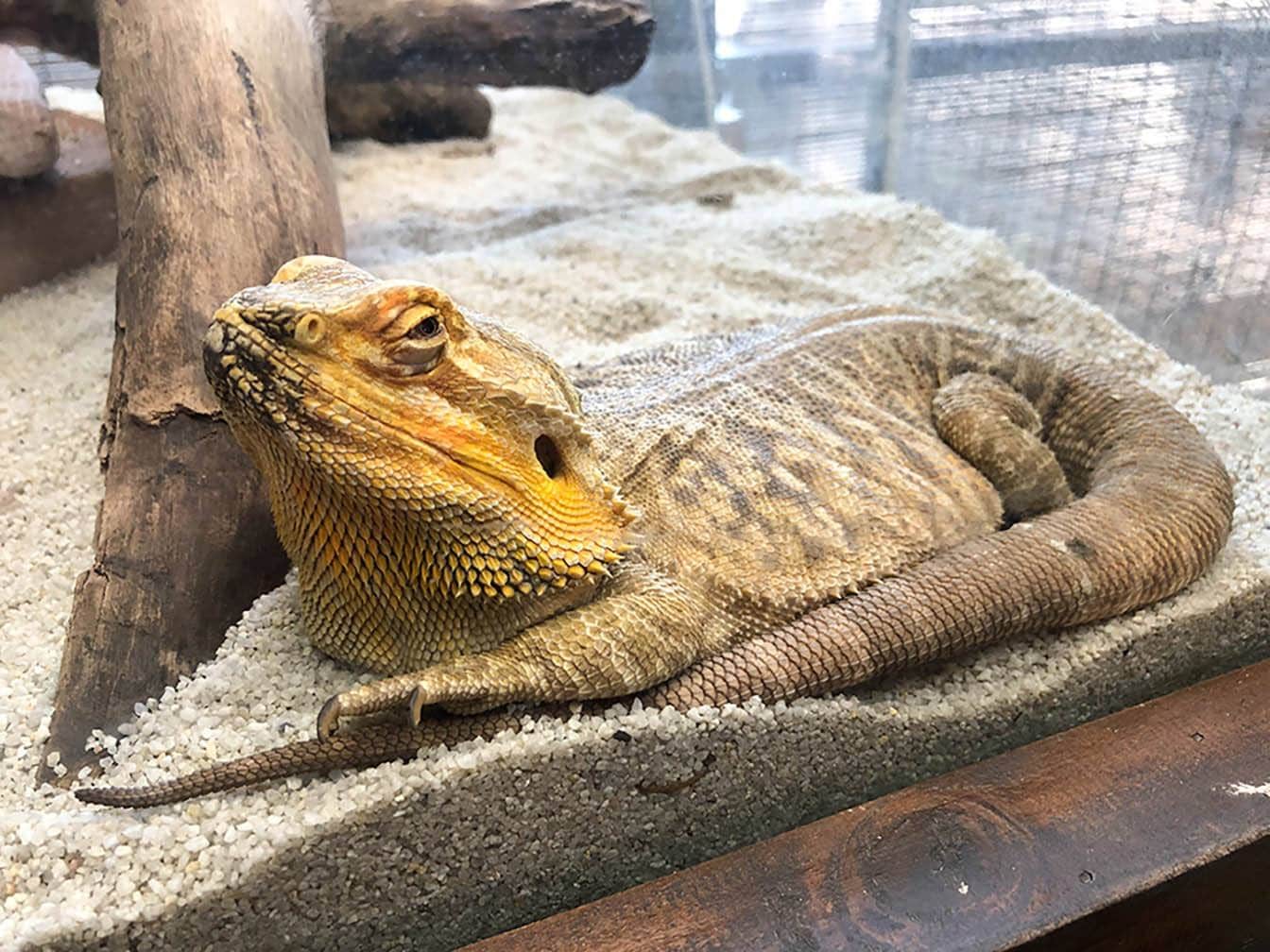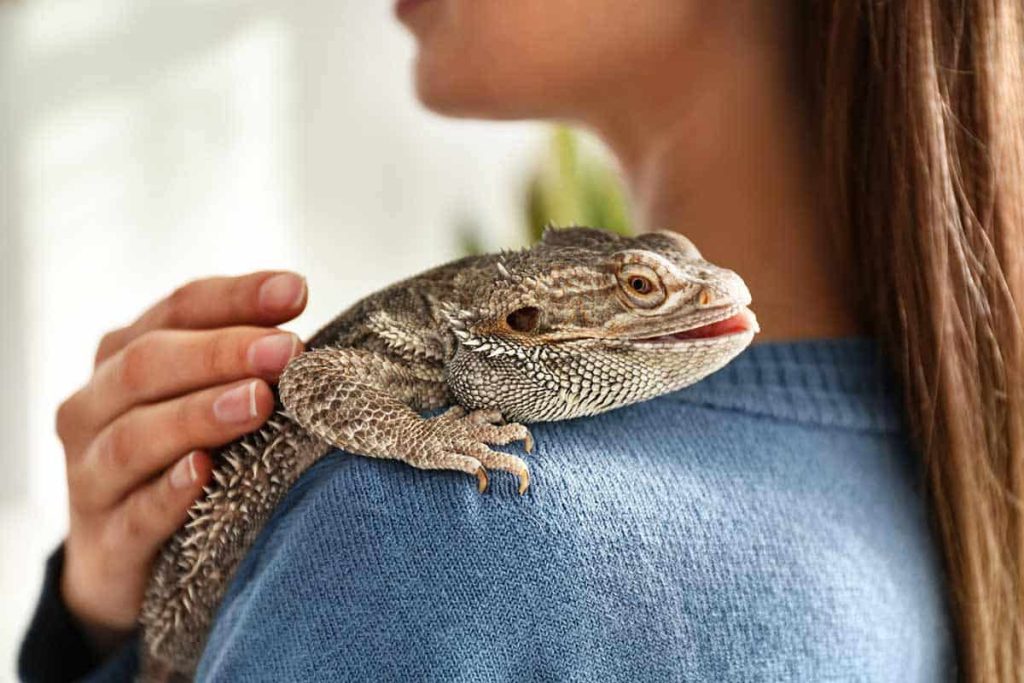We often keep dogs, cats, or rabbits as our pets. Like dogs, cats, and rabbits, bearded dragons can also be kept as pets. In semi-arid or arid areas, they are commonly found all over Australia. Bearded dragons are known as pogona in scientific terms.
Bearded dragons are excellent choices if you’re looking for a reptile to keep as a pet. Most bearded dragons eventually get used to being held by their owners. Additionally, they are taught to appreciate, love, and recognize the touch of their owners.
People who keep these lizards as pets love to spend time with beardie. Whether it’s letting him sleep on their shoulder, exploring the room, or holding them and giving them affection and love, these activities are very much enjoyed by bearded dragons.
Understanding the Solitary Nature of Bearded Dragon
Bearded dragons are solitary animals. Solitary nature means they may thrive and stay healthy without social interaction. Due to their solitary nature, bearded dragons do not experience loneliness when separated from their owners or left alone in a cage. Instead of sharing their food and heat with others, they prefer to keep it to themselves. In general, they don’t require or want companions. Unless they are a breeding pair, they usually live alone in their enclosure as adults.
Bearded Dragons Are Curious

Beardies’ curiosity for their owners is one of the first signs that they like them. Pet beardie, who we keep in our home or office, enjoys sitting and watching our work. They follow our every move with their stare.
They frequently approach us and begin climbing if we have them outside and they are doing some exploration. They will occasionally even curl up in our laps and take a quick snooze. It’s very cute! The fact that they enjoy being with us is also a great sign. They desire company and attention.
Do Bearded Dragons Like to Be Held?
Despite the lone nature of bearded dragons, they become attached to their owners. Usually, bearded dragons like being held. Especially if someone takes a young beardie in as a pet, they get used to and even grow to like being held. Bearded dragon owners with adult bearded dragons might face difficulties in getting their pet beardie to snuggle.
But as time passes and the owners frequently hold and cuddle their pet lizards, even adult bearded dragons enjoy being held. Although, if you have an aggressive bearded dragon, it may simply not like being held. In this case, it’s best if you leave them alone. Nonetheless, every bearded dragon has its own personality, and it differs from dragon to dragon.
How to Handle Your Bearded Dragon?
Before keeping a bearded dragon as a pet, you must understand how to read a dragon’s body language. This is particularly true when you get your first bearded dragon, and it is uncomfortable with you or being handled. When dealing with bearded dragons, there are some dos and don’ts to remember. To learn how to handle your bearded dragon, follow these simple steps which are given below:
step-01

After touching your bearded dragon, you should wash your hand with soap and water or put gloves on your hand. This system will protect your bearded dragon from all kinds of germs and bacteria. And bite proof gloves are best to protect your fingers. Although many people don’t think it necessary. But I think it is better to wash your hands or wear gloves.
step-02

You should approach the bearded dragon slowly and calmly. Beardies often exhibit poor reactions to rapid movements. You should carefully advance until you are adjacent to the bearded dragon, at which point you should slowly extend a hand.
Stress will be indicated by bearded dragons. Avoid coming at your bearded dragon from directly above. Because their predators attack them from above in the habitat, bearded dragons have receptor cells on the top of their heads. A bearded dragon will perceive your attempt to capture them from straight above as a predator attack.
step-03

you should Make gentle contact when you pick up a bearded dragon. Make some gentle, non-threatening physical contact with your bearded dragon to let it become more used to you before attempting to raise it. Stroke your bearded dragon softly on the head, or you can place your index finger on its front legs. And again, keep an eye out for indications that the bearded dragon is upset or anxious. A bearded dragon’s mouth opening wide is another indication that it is striving to look as intimidating as possible.
step-04

You must support the base of the tail, the back legs, and the front legs of a bearded dragon when lifting it. Your bearded dragon will feel uneasy if any of these areas are not supported. Start by holding up its front legs. To make the bearded dragon stand on your hand, slide your hand between its front legs. You can also do this by gently lifting the front of its body.
step-05

You should Scoop the bearded dragon up from the rear while continuing to support its front. Once the front of your bearded dragon is supported, you may lift it into the air by sliding your other hand underneath its back. One hand should hold its front legs and body while the other should hold its back legs, the tail’s base, and the back portion of its body. If all went according to plan, your bearded dragon should be sitting quietly in your hands.
Keep in mind that you should only be supporting the bearded dragon with your hands, not squeezing it. Not supporting a bearded dragon’s rear legs and tail base when handling one is a typical error. A bearded dragon frequently starts to thrash its tail circularly when unsupported. This implies that the dragon is uncomfortable and that, over time, its back could become injured.
step-06

You can move your bearded dragon into a more comfortable posture once you’ve lifted and supported it. One typical method of holding a bearded dragon is to cradle its body with the entire forearm. In this posture, the bearded dragon’s head may rest in your palm or, in the other direction, in the crook of your elbow. Others prefer to place their bearded dragon on their chest or shoulder to rest there.
Signs Your Bearded Dragons Like Being Held
In the world of beardies, a hug is actually not that different from one given to a cat or dog. Bearded dragon hugs primarily consist of the animal curling up on you and possibly moving on to request a light ear scratch. Bearded dragons are very capable of learning. They connect scent and sound very quickly with the experience you give them.
So, if your pet beardie likes you, they will show you that they want to be held. There are signs that your bearded dragon is comfortable letting you pick them up :
- If they come to your hand as you pet and stroke them gently,
- Comes when you put your hand into the terrarium voluntarily, whether you’re holding food or not.
- If they swoop down on you.
- Closing their eyes while you brush around their ears, rub their tiny legs, or touch their back.
- Gaining access to your shoulders and cuddling up to your neck.
- If they are relaxed with you.
- Displays delight and recognition when you approach their terrarium.
- For at least a brief period, remains motionless on your lap.
- Searches for you when they’re anxious or afraid.
What Not To Do When Handling a Bearded Dragon
There are things that you shouldn’t do whilst handling your pet lizard.
- For instance, when your dragon is sleeping, you should restrain from picking them up at that time. It’s not a very pleasant encounter for them if their sleep is disrupted.
- You would also want to avoid sudden movements while handling your pet. If your bearded dragons make hissing sounds, puff up, and turn their beard black, put them back as soon as possible. This is a sign that your lizard does not like to be held at that time.
- If your beardie isn’t used to your touch or doesn’t let you hold them, you can opt to pet your beardie for starters. The place between their eyes and their beard can be good spots to pet.
- You should also never hold a bearded dragon by the tail. This really irritates them. While petting them, you should do that in the direction of their scales.
- Never stroke them against their scales.
- You should also keep the room’s temperature in mind while spending time with your dragon. As they are cold-blooded animals and can only receive heat from outside sources, it’s best if you keep the temperature of the room to the optimal temperature of their liking.
- If you see that they are slowing down or not making movements for a significant amount of time, warm them up by putting them under their basking lamp, as a drop in body temperature can be vital for these creatures.
Conclusion
Being exotic animals, bearded dragons might be a bit difficult to understand. But as you get to know your bearded dragon and handle your beardie in a right and affectionate way, it will eventually like to be touched by you. These dragons like to be petted and, like humans, are down for cuddling. Many bearded dragons take time to adjust to their new owners. Take the time to get to know your pet, and you’ll find your new lizard to be one of the most amazing creatures to roam around your home.
FAQs
1. How often should you hold your bearded dragon?
Bearded dragons benefit from everyday handling to help them become accustomed to people. Additionally, doing so reduces tension experienced during routine maintenance tasks like bathing or tank cleaning. In general, they are soft and comfortable to hold.
2. Should you kiss a bearded dragon?
Avoid cuddling, kissing, and eating or drinking in close proximity to your bearded dragon. Salmonella bacteria may enter your mouth through this, making you sick. Do not let your bearded dragon enter the kitchen or any other room where you make, store, or consume food.
3. Does bearded dragon bites hurt?
Avoid cuddling, kissing, and eating or drinking in close proximity to your bearded dragon. Salmonella bacteria may enter your mouth through this, making you sick. Do not let your bearded dragon enter the kitchen or any other room where you make, store, or consume food.
4. How long do bearded dragons live?
Since they often have a lifespan of 10 to 15 years or longer, they require a significant investment. As close as you can, try to imitate their natural environment. Find out more about how to look after and maintain the happiness and health of your bearded dragon.
5. Does bearded dragons cry?
A lot of reptiles cry, including bearded dragons, but this is not because they are unhappy; rather, the tears help to protect and clean out their eyes.
Hugues Beaufrere is the Exoticpetia’s senior writer and reptile expert. He has been fascinated by reptiles and monkeys since he was a kid and had years of experience in herpetology and primatology. He has cared for various kinds of Monkeys, Lizards and Reptiles and loves to share his knowledge and passion with others.


